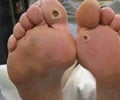Tiny drug-delivering capsules can help sustain insulin-producing cells to treat diabetes effectively finds a new study.
Highlights
- Drug-carrying microsphere (tiny capsule) could be the key in extending the duration of insulin-secreting pig pancreas cells (islets) in human patients whose own cells have been destroyed by type I diabetes.
- Once islets are isolated from tissue of the donor, the next big challenge is to keep them alive and functioning after being taken inside the human body.
- Viability and function after spending 21 days inside tiny capsules can make the drug more resilient to oxygen deprivation and immune system degradation.
"First, you need viable islets that are also functional, so that they secrete insulin when exposed to glucose," said Illinois electrical and computer engineering professor Kyekyoon "Kevin" Kim, the leader of the new study. Islets from humans are scarce, he said, but pig tissue is in abundant supply, and pig insulin has been used to treat diabetes since the 1920s.
Once islets are isolated from tissue, the next big challenge is to keep them alive and functioning after transplantation.
To keep the transplanted cells from interacting with the recipient’s immune system, they are packaged in tiny, semipermeable capsules. The capsule size and porosity are important to allow oxygen and nutrients to reach the islets while keeping out immune cells.
"The first few weeks after transplant are very crucial because these islets need oxygen and nutrients, but do not have blood vessels to provide them," said Hyungsoo Choi, the study’s co-leader and a senior research scientist in electrical and computer engineering at Illinois. "Most critically, lack of oxygen is very toxic. It’s called hypoxia, and that will destroy the islets."
"For a typical patient, you’d need about 2 million capsules. Production with any other method we know cannot meet that demand easily. We’ve demonstrated that we can produce 2 million capsules in a matter of 20 minutes or so," Kim said.
The microspheres were designed to provide an extended release of the drug over 21 days. Researchers packaged pig islets and the microspheres together within microcapsules, and over the next three weeks compared them with encapsulated islets that didn’t have the drug-containing microspheres.
After 21 days, around 71 percent of the islets packaged with the drug-releasing microspheres remained viable, while only about 45 percent of the islets encapsulated on their own survived. The cells with the microspheres also maintained their ability to produce insulin in response to glucose at a significantly higher level than those without the microspheres.
Next, the researchers hope to test their microsphere-within-a-microcapsule technique in small animals before looking toward larger animal or human trials.
Reference
- Benjamin Lew In-Yong Kim, Hyungsoo Choi, Kyekyoon (Kevin) Kim. Sustained exenatide delivery via intracapsular microspheres for improved survival and function of microencapsulated porcine islets, Drug Delivery and Translational Research (2018).DOI: https://doi.org/10.1007/s13346-018-0484-x
Source-Eurekalert
















